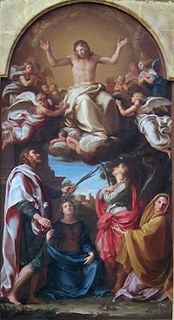Lorenzo Ruiz, also called Saint Lorenzo of Manila, is a Filipino saint venerated in the Catholic Church. A Chinese-Filipino, he became his country's protomartyr after his execution in Japan by the Tokugawa Shogunate during its persecution of Japanese Christians in the 17th century.

In Christianity, a martyr is a person considered to have died because of their testimony for Jesus or faith in Jesus. In years of the early church, stories depict this often occurring through death by sawing, stoning, crucifixion, burning at the stake or other forms of torture and capital punishment. The word martyr comes from the Koine word -> μάρτυς, mártys, which means "witness" or "testimony".

Cassian, or Saint Cassian of Imola, or Cassius was a Christian saint of the 4th century. His feast day is August 13.

Alexander Briant was an English Jesuit and martyr, executed at Tyburn.

Saint Blandina was a Christian martyr who died in Lugdunum during the reign of Emperor Marcus Aurelius.

Constantius of Perugia is one of the patron saints of Perugia, Italy.
Saint Adrian travelled from Batanea to Caesarea Palaestina, where he was martyred together with Saint Eubulus. He is commemorated on 5 March; Eubulus on 7 March.

Alexander of Jerusalem was a third century bishop who is venerated as a martyr and saint by the Eastern Orthodox Church, Oriental Orthodox churches, and the Roman Catholic Church. He died during the persecution of Emperor Decius.
Saint Abdecalas was a Persian priest of advanced age who, together with another priest, Saint Ananias, and about a hundred other Christians, was killed under the Persian ruler Shapur II on Good Friday, 345. One of these others was also named Abdecalas.

The persecution in Lyon in AD 177 was a persecution of Christians in Lugdunum, Roman Gaul, during the reign of Marcus Aurelius (161-180). An account of this persecution is a letter preserved in Eusebius's Ecclesiastical History, book 5, chapter 1. Gregory of Tours describes the persecution in De Gloria martyrum.

Julian and Basilissa were husband and wife, and are venerated as saints in the Roman Catholic Church and the Eastern Orthodox Church. They were Christian martyrs who died at either Antioch or, more probably, at Antinoe, in the reign of Diocletian, early in the fourth century, on 6 January, according to the Roman Martyrology, or 8 January, according to the Greek Menaea.
Concordius of Spoleto is a little-known Christian saint and martyr of the 2nd century. There is another martyr Concordius who died in the 4th century.
Elias and four companions, Daniel, Isaiah, Jeremiah, and Samuel were Egyptian martyrs. Their feast day is February 16.
Jacobo Kyushei Gorobioye Tomonaga de Santa María was a Japanese Dominican priest. He composed one of the first modern Japanese dictionaries.
Abibus of Samosata was a Christian martyr at Samosata. He lived during the period of Diocletianic Persecution. He was arrested for refusing to take part in a pagan ritual to celebrate the victory of Emperor Maximian over the Persians. He was thrown to prison where his body was scratched with iron, he had heavy shackles over his neck. In 297 he was sentenced to be executed by crucifixion. After having lived for two days on the cross, he was taken down and his head was pierced by nails. He was crucified together with other martyrs – James, Romanus, Lollius, Philotheus and Paregrus. All these martyrs were commemorated on 29 January in the Byzantine Church and by the Armenian Church in October.
Agrestius Chromatius was a city prefect in Rome under Diocletian. He condemned several martyrs to death in the reign of Carinus. He was later converted to Christianity by St. Tranquillinus and baptized by Polycarp. This happened because of Tranquillinus' testimony that he had been cured of gout during baptism. Chromatius suffered from the same malady, so he sent for Polycarp, who baptized him, and he was also healed.
Hormizd, the Persian Martyr is a Catholic saint of the fifth century. Theodoret, in his Historia Ecclesiastica presents the history of the life and the martyrdom of Hormizd, the Persian. The 1583 version of the Roman Martyrology included the name of St. Hormizd, the martyr, fixing his feast on the 8th of August. Since then he has been revered as a saint in the Catholic Church. An English version of the Roman Martyrology was published in 1907, entering the name of the saint as "In Persia, St. Hormisdas, a martyr," under 8 August. Whether, the Christians of St. Thomas accepted it or not, the Synod of Diamper strategically substituted the Rabban Hormizd with the name of Hormizd, the martyr in 1599 in order to assure that the Christians "are saved" from every Nestorian influence. However, as a turn of history, Rabban Hormizd himself is presently a saint of the Chaldean Catholic Church.
Roger of Ellant was a Christian abbot who is considered blessed by the Catholic Church.
Saint Brynoth of Skara was a medieval Swedish bishop who was canonized in 1498. His feast day is 9 May.
Saint Agathodorus was an early Christian martyr in Pergamon, Asia Minor.